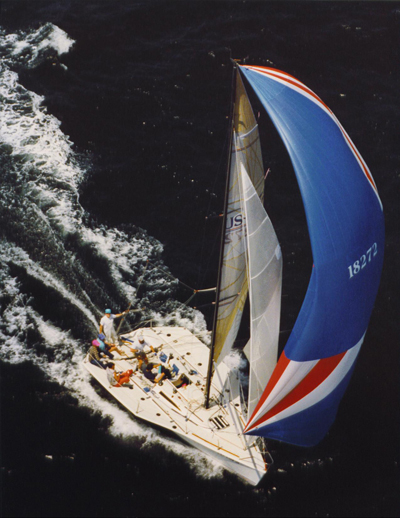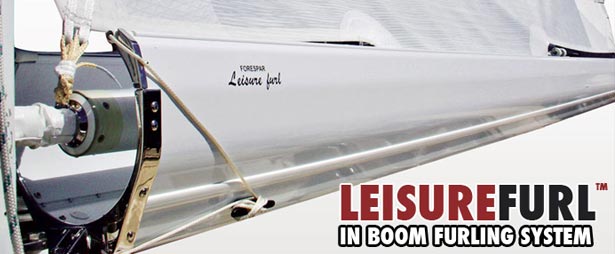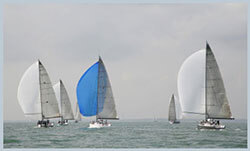Forespar® Products Corp
Basics
The American Boat and Yacht Council defines a “seacock” as a “fitting(s) which serve water lines which penetrate the hull at or below the maximum heeled waterline”. Their general requirement is stated in H-27.4 “Requirements-In General” as “All piping, tubing or hose lines penetrating the hull below the maximum heeled waterline and under all normal conditions of trim shall be equipped with a seacock to stop the admission of water in the event of failure of pipes, tubing or hose”. Note that the heeled water line on a powerboat is 7o of heel and to the hull/deck joint of a sailboat.
Underwriters Laboratories calls these same units “sea valves” and define them as “products designed to provide positive closure in a piping system of a marine craft’s hull. They are usually used in conjunction with a threaded thru-hull fitting.” (Ref; U.L. file #MQ1131, Vol.1, Sec.1, Page 1, Issued 6/9/92 revised 7/1/92)
History
A seacock or sea valve is a device that positively stops the inflow of water into a vessel. They come in many forms and materials, however, it is generally agreed in the marine marketplace that a true “seacock” has a flange or other means of mounting the valve to the inside of the hull. A ball valve or simply, a “valve” does not necessarily have this flange mount. Both are, and have been used in custom and production boat building for many years. Gate valves installed on top of a thru-hull was common practice in the 60’s and early 70’s and was generally considered “the way to do it” at that time.
Ball valves replaced the gate valves eventually, as the ball valves were easier to operate and could be seen as “closed” or “open” by the position of the handle, whereas gate valves had to be turned to tell if they were open or closed. Gate valves also had dissimilar metals in their handles and stems making them prone to corrosion and seizure. True seacocks were made, and are still made, by Gross Mechanical (Groco) and Wilcox as well as Perko and many other offshore manufacturers. All were made of bronze.
In the late 1970’s, a search was undertaken for a material that could replace the traditional bronze plumbing components in boats. The frequency of severe corrosion, and the problems of conductivity in bronze, had long been a source of frustration for designers and boat builders. Bronze was also heavy, and modern advancements in lightweight hull materials made its continued use impractical for composite hull construction. So, also in the late 1970’s, tooling was made for the production of valves, seacocks, thru-hull fittings and hose connectors by injection molding of well-tested polymer composites. The Auckland Tool and Gage Company in New Zealand undertook this. They were marketed by R.C. Marine® and imported by Forespar® from 1981 until Forespar® purchased the tooling in 1986 and began molding the parts at our plant in Rancho Santa Margarita, California.
Composite polymer showed the best engineering properties for the desired parts given their intended use. Other polymers were available, however, they either would not handle the strength, the creep resistance, temperature ranges or the U.V. exposure in the harsh marine environment. The composite polymer had the right mix of mold-ability and stability for use as marine plumbing components. Since that date, products now produced by Forespar® under the name Marelon®, have been installed in several hundred thousand pleasure and commercial vessels the world over.
Marelon®
All composite polymers are “hydroscopic”. This is a fundamental element of the material. “Hydroscopic”, as is used in the engineering description, means that the raw material must be dried or desiccated before molding. The material then absorbs moisture from the air within days after being molded to return the material to equilibrium, and its original engineered properties. The material then does not absorb any appreciable additional moisture and is dimensionally stable from that point on. This hydroscopic characteristic is allowed for in all tooling designs from the start. In our “93” series Integrated Plumbing System valves, all the seals are “dynamic”; that is they are backed with compressible “O”-rings that adjust for any minor changes in ball dimensions.
Standards
Around 1987, the A.B.Y.C. established a set of “standards” for recreational watercraft that included guidelines for plumbing components. This was the early stage of the H-27 “Recommended practices and standards covering seacocks, thru-hull fittings, and drain plugs.” By 1989 this was published by the A.B.Y.C. and builders were encouraged to comply. By 1991 the Marine U.L. began incorporating the A.B.Y.C. standards into their standards. The biggest change from the original U.L. standard was the A.B.Y.C. addition of a 500 lb. load test applied to the “outermost fitting” (the tailpipe) of the valve “system”. This was the first time a seacock was viewed as a “system” including the thru-hull and tailpipe (or 90 deg. elbow) for hose attachment.
Up until that time, the MF 849 style flanged seacocks were the only style Marelon® valves approved by the U.L. We sold many of these units to Catalina Yachts as well as T.P.I., Hinckley, C. & C. and a host of other prominent production sailboat builders. These units are still sold today, although they no longer have U.L. approval. The MF 849 ½”, ¾” and 1-1/2” style valves and the MF 850 1” through 2” style valves would still pass the current U.L. test if submitted. We let the U.L. approval drop when the new “93” series integrated plumbing systems were introduced. Forespar® had to design a new system that would meet and exceed the “new” U.L. standard as recommended by the A.B.Y.C.
In early 1992, Forespar® undertook the challenge of redesigning marine plumbing in our Marelon® material to meet these new guidelines. This required a tremendous amount of resources as a complete “system” had to be designed, tooled and molded to meet the increasing demand for Marelon® plumbing. This was the beginnings of what we now generally call our “93” series of integrated plumbing systems. The tooling was completed, parts molded and sent to the U.L. for approvals in late 1992. By the spring of 1993, we showed this system in our catalog and we began shipping parts to Catalina Yachts as well as Sea Ray Boats and a very large number of production builders. They have grown in acceptance with production and custom builders every year since then.
Today
Marelon® plumbing is now used by custom builders such as Wally Yachts, Oyster, Swan, Baltic, Morris and many other production builders such as Wellcraft, Boston Whaler, Sabre, Godfrey, Triton, Hinkley, S-2, Baja, Cobalt, and more than 100 others, power and sail. Virtually all North American production boat builders use some Marelon® plumbing components in their boats. Forespar® ships over 45,000 valves a year to service these builders and have been supplying quality-plumbing components made of engineering polymers since 1982.
Maintenance
From the very early days of our involvement in synthetic plumbing, the question of maintenance has been raised. It was thought by the consumer that being “plastic” no maintenance would be required. Not so. Any valve below the waterline, bronze or plastic, will become difficult to operate or possibly seize if left stationary for a long period of time. Marine growth will fowl synthetic valves same as bronze. Marelon® gives you freedom from electrolysis and corrosion but not from the routine maintenance required of any marine valve. They also need to be lubricated periodically. This requires that the valve be closed, the hose removed, excess water sponged out, and the ball lubricated with a suitable grease. Then the hose reattached and the handle worked a few times to draw the lubrication to the seals. Again, a normal requirement of any seacock. Because they are “plastic”, this normal maintenance requirement seems to be ignored by many of today’s generation of boat owners.
Plumbing in boats today has been pushed into cabinets, behind bulkheads or hidden under the equipment they serve. This is due to the lack of bilges in modern hull design. It was easy in the “old days” when you had 6” or more of bilge under the sole. Now we have valves that need to be serviced regularly not even being activated let alone lubricated by boat owners. These valves may become very hard to turn or seize. It is not a design flaw or materials problem, it is a simple maintenance issue. All valves need to be regularly operated and lubricated periodically. Just like an engine needs an oil change or halyards need replacing or winches need to be lubricated. It is general maintenance. No manufacturer can make an item that has moving parts that will be immersed in the water, without the need for periodic maintenance.
The next question that is raised is what to use as lubrication. Marelon® has excellent chemical resistance. It is naturally lubricious to some degree but needs lubrication to properly work with the seals in the valve. Winch grease or LanoCote® will work. Water-pump grease is good also. PTFE (TEFLON®, a registered trademark of DuPont) lubes are very effective. In the past, vegetable oil was mentioned in some articles, however this was possibly in error or misunderstood. Vegetable oil will work, but mineral oil would be better. All must be used at least once a year to insure the continued easy operation of the valve’s handle. If a valve’s operation becomes stiff, the valve should be closed and immediately serviced. This requirement is similar to that made by all other manufactures of marine valves. This is basic “boat” maintenance and must be followed to insure the safety of the vessel.
The handles (more specifically, the ball-stem/handle connection) on Marelon® valves have, over 15 years, been modified and strengthened more than once. R.C. did it and Forespar® did them again. The valve/handle system on today’s valves are far stronger than those made a few years ago. They have been enlarged, reshaped and extended so they will withstand the torque people apply---even in the wrong direction. We know that many failures in the past were due to the handles being forced the wrong direction against the stop. (If the stops were eliminated it would compromise the certainty that the valve is not partially open or closed.) Use enough force and the handle would either break or be forced off the stem. Use enough force on a bronze valve and you bend the handle. Both outcomes make the valves inoperable.
Even today, with all the changes in this connection, we have had some handles broken or stems sheared. How many? Between two and three calls a month or about 30 a year. That amounts to one valve out of every 1500 valves shipped. In most cases, we have been able to identify that the cause of failure was due to leverage applied outside their arc of activation. Basically, the handles have been pried off. How? By the operators attempting to activate the valves in a cramped space where they cannot see which direction is correct to open or close the valve. In many cases, it was the first time the valve had ever been used since the boat was commissioned. In some cases the owners, when advised of the maintenance requirements, tell us that they cannot get the hoses off to lubricate the valves.
This maintenance is not easy given the space constraints, the stiffness of the hose and the location of many of these valves. Nobody said it would be easy! On a car, if the water hoses need to be replaced, you take it a qualified mechanic. Why would you expect a boat to be any different? There are many items on board that need repair or replacement that are beyond the average consumers expertise. Rigging, furling systems, electronics, all have service lives that require their replacement or repair. Most boat owners have no problem calling a qualified rigger to replace a shroud or spreader tip. They call an electronics expert to sort out electrical problems or auto pilot problems. It should be of similar consequence to have a professional take care of valve maintenance once a year.
During the 2000 IBEX convention, I was asked to participate in a panel discussion on marine valves and specifically their location and accessibility. In this group discussion it was evident that valves are mounted in boats today with little attention given to their future service or maintenance requirements. Marine surveyors and boat yard personnel echoed this problem. Lack of maintenance was the principal cause of valve failures, bronze or Marelon®.
Forespar® makes the Marelon® valves to a company standard greater than that of the U.L. or A.B.Y.C. They are made as strong as is practically possible. This strength, however great, will never be enough to negate the need for maintenance. We are boaters also. We use these valves on our own boats. I personally have the MF 850 style ball valves installed on top of Marelon® thru-hulls in my boat. They have served the head system for over 12 years without any problems. They are used regularly.
Future
Forespar® will continue to research materials, production techniques and designs to continue the manufacture of the highest quality, reliable marine plumbing components made of engineered polymers (Marelon®) possible. We are involved in the international standards committee for the I.S.O. and have been on panel discussions for the A.B.Y.C. concerning seacocks. We are very committed to the further development and use of polymers in the construction of boats and the equipment they require above and below the waterline.
Recently, the ISO committee sent a draft of their proposed recommendations to all committee members. This draft includes materials, thread form, strength requirements, U.V. test requirements, and hose attachment methods as well as many other specific requirements, (29 to be exact) as would be required for all seacocks used on small craft to 24 m (78 feet). This standard, when ratified by the full international committee, will cover our seacocks in the international certifications arena. The requirements are similar to the Marine U.L. (as recommended by the A.B.Y.C.) and Marelon® Integrated Plumbing systems (our “93” series valves) will comply. As of October 10th, 2001 the I.S.O. working committee has issued a “Working Document” #ISO/TC 188 N/XXX concerning the Small Craft Directive-Seacocks and through-hull fittings-Part 2: Non-metallic, in which the material requirements for valves and through-hulls are outlined. Marelon® exceeds all strength requirements as stated in this document. I will mention at this point that none of the international requirements we have seen to date are as comprehensive or stringent as our own Marine U.L. requirements as set forth by the A.B.Y.C.
Marine plumbing is not rocket science. However, the proper use of engineered polymers and mold techniques comes very close. There are many forms of “plastics” used in our industry every day. Forespar® has over eighteen years experience in “plastic” plumbing. If this were easy, there would be more than one manufacturer vying for this market. We are the only company to date that has designed, tooled and molded valves and components in any materiel other than bronze or stainless steel that meet and pass the U.L. standards and testing.















